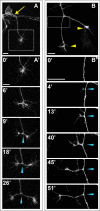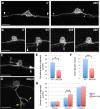In vivo imaging of cell behaviors and F-actin reveals LIM-HD transcription factor regulation of peripheral versus central sensory axon development
- PMID: 21619654
- PMCID: PMC3121664
- DOI: 10.1186/1749-8104-6-27
In vivo imaging of cell behaviors and F-actin reveals LIM-HD transcription factor regulation of peripheral versus central sensory axon development
Abstract
Background: Development of specific neuronal morphology requires precise control over cell motility processes, including axon formation, outgrowth and branching. Dynamic remodeling of the filamentous actin (F-actin) cytoskeleton is critical for these processes; however, little is known about the mechanisms controlling motile axon behaviors and F-actin dynamics in vivo. Neuronal structure is specified in part by intrinsic transcription factor activity, yet the molecular and cellular steps between transcription and axon behavior are not well understood. Zebrafish Rohon-Beard (RB) sensory neurons have a unique morphology, with central axons that extend in the spinal cord and a peripheral axon that innervates the skin. LIM homeodomain (LIM-HD) transcription factor activity is required for formation of peripheral RB axons. To understand how neuronal morphogenesis is controlled in vivo and how LIM-HD transcription factor activity differentially regulates peripheral versus central axons, we used live imaging of axon behavior and F-actin distribution in vivo.
Results: We used an F-actin biosensor containing the actin-binding domain of utrophin to characterize actin rearrangements during specific developmental processes in vivo, including axon initiation, consolidation and branching. We found that peripheral axons initiate from a specific cellular compartment and that F-actin accumulation and protrusive activity precede peripheral axon initiation. Moreover, disruption of LIM-HD transcriptional activity has different effects on the motility of peripheral versus central axons; it inhibits peripheral axon initiation, growth and branching, while increasing the growth rate of central axons. Our imaging revealed that LIM-HD transcription factor activity is not required for F-actin based protrusive activity or F-actin accumulation during peripheral axon initiation, but can affect positioning of F-actin accumulation and axon formation.
Conclusion: Our ability to image the dynamics of F-actin distribution during neuronal morphogenesis in vivo is unprecedented, and our experiments provide insight into the regulation of cell motility as neurons develop in the intact embryo. We identify specific motile cell behaviors affected by LIM-HD transcription factor activity and reveal how transcription factors differentially control the formation and growth of two axons from the same neuron.
Figures






References
Publication types
MeSH terms
Substances
Grants and funding
LinkOut - more resources
Full Text Sources
Molecular Biology Databases

